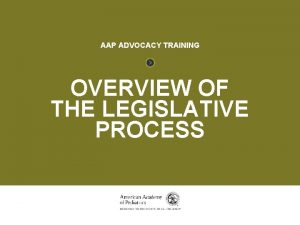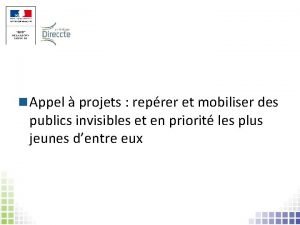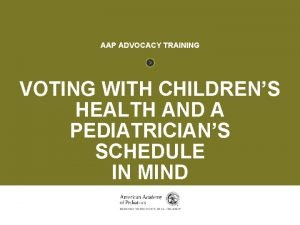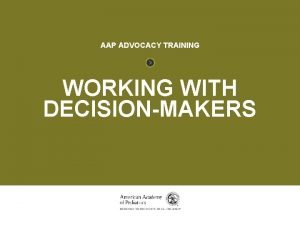ADVOCACY COMMUNICATIONS AAP ADVOCACY TRAINING ADVOCACY COMMUNICATIONS ADVOCACY









- Slides: 9

ADVOCACY COMMUNICATIONS AAP ADVOCACY TRAINING ADVOCACY COMMUNICATIONS

ADVOCACY COMMUNICATIONS MEDIA ADVOCACY AND COMMUNICATION DEFINED • Intentional use of any type of media or communication mechanism to bring about awareness and change on behalf of your issue. • Media advocacy: Using media (newspapers, magazines, television, radio, and internet) to reach broader audience to build awareness on behalf of an issue and gain more attention from decision-makers. • Communications advocacy: Any material and mechanism (other than the media) used to create awareness around an issue, get others involved, or influence decision-makers. Examples include making a guest presentation to a group or hosting an information table at a public event.

ADVOCACY COMMUNICATIONS WHY MEDIA ADVOCACY AND COMMUNICATIONS • Persuades decision-makers to act because they believe public is paying attention. • Increases likelihood that more people will get involved because they are aware of issue and how they can help change circumstances affecting the children they know and care about. • Establishes credibility on behalf of your issue by demonstrating how it affects many people and deserves the public’s attention.

ADVOCACY COMMUNICATIONS MEDIA ADVOCACY AND COMMUNICATIONS POINTERS Two important things to keep in mind when using media and communications to advance your issue: • your message • how you deliver your message

ADVOCACY COMMUNICATIONS YOUR MESSAGE • Your message is the core statement of why your issue is important and should be the underpinning of all your media and communications work. EFFECTIVE MESSAGES: • Create consistency and cut across the many stories that relate to your issue. • Are easily understood and can be internalized and repeated by others. • Convince people that your issue is something they can support.

ADVOCACY COMMUNICATIONS CRAFTING YOUR MESSAGE • Essentially, your message is what follows because…. Consider the following example of a message: “Medicaid and CHIP are indispensable health programs because they provide health insurance coverage to over 25 million low-income children who otherwise wouldn’t have access to critical and much needed health care services. ” • This message makes the case about the importance of Medicaid and CHIP funding. Your personal experiences and stories of working with children who are uninsured can then help support this message.

ADVOCACY COMMUNICATIONS CREATING AN EFFECTIVE MESSAGE Consider the following points as a guide to creating an effective message: • • • clear concise memorable and relatable persuasive repeat, repeat

ADVOCACY COMMUNICATIONS HOW TO DELIVER YOUR MESSAGE • Combine your message with personal stories to illustrate the importance of and to put a human face on an issue. • Connect your message to what is happening locally. • Highlight solutions and inform others of how they can help bring about a solution.

ADVOCACY COMMUNICATIONS ADDITIONAL RESOURCES & INFORMATION • AAP Advocacy Guide (www. aap. org/moc/advocacyguide) • AAP Member Media Center (www. aap. org/moc/pressroom. htm) • AAP Chapters (www. aap. org/member/chapters. htm) • AAP Division of State Government Affairs (www. aap. org/moc/stgovaffairs) • AAP Department of Federal Affairs (http: //federaladvocacy. aap. org ) • AAP Community Pediatrics Training Initiative (www. aap. org/commpeds/CPTI)















